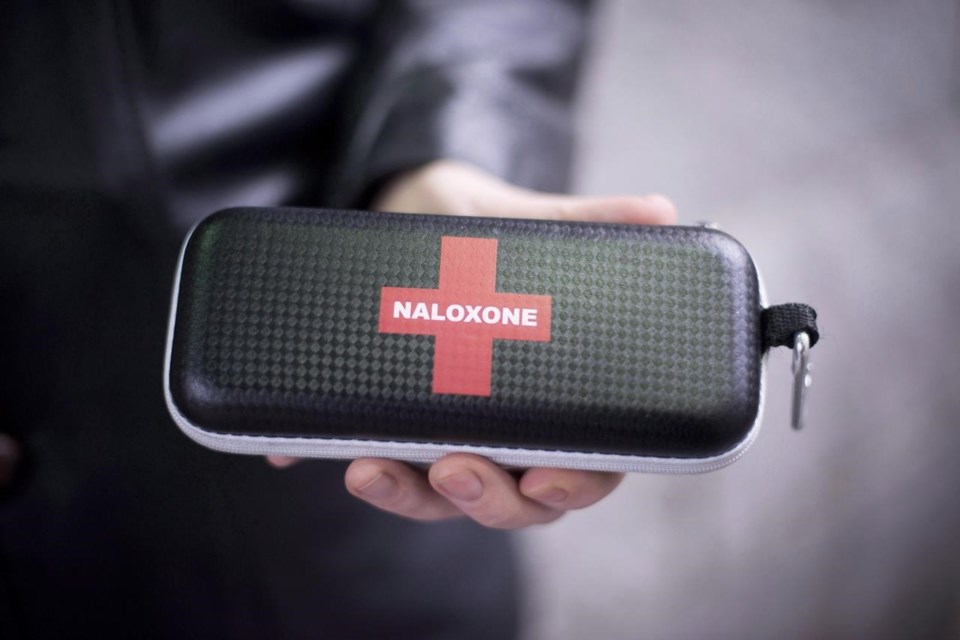HALIFAX — Health Canada has called the opioid crisis one of the most serious public health threats in recent history, and an addictions specialist says everyone can play a part in helping reduce the death toll. All it takes is access to naloxone, a life-saving medication that temporarily reverses an opioid overdose.
“It’s something that all adult Canadians, and I would hazard to guess teenagers as well, should have access to and be aware of,” said Dr. Sam Hickcox, chief officer of the Nova Scotia government's Office of Mental Health and Addictions. “If there's something we could do to save a life, why wouldn't we?”
He compared administering naloxone to using an EpiPen to treat someone having an anaphylactic allergic reaction.
Hickcox said the country's ongoing opioid epidemic has been made worse as Canada’s illicit drug supply became “poisoned” in recent years with toxic, highly potent opioid additives like fentanyl and carfentanil. Some users report not knowing what's in the drugs they're using.
"It's been wreaking havoc across the country ... starting in the West Coast and heading eastward," he said in a recent interview.
Since 2016, Health Canada has recorded 38,514 opioid-related overdose deaths. Between January and March this year, there were more than 1,900 apparent opioid overdose deaths in the country, an average of 21 a day.
Widespread access to naloxone is “not just about potentially saving someone's life — it's also about all of us playing some part in this and understanding this problem more," Hickcox said.
Here’s what you should know about naloxone, a life-saving treatment that can be administered by the average Canadian and is free to obtain.
What is naloxone and when is it used?
Naloxone is a medication that blocks receptors in the body that take in opioids such as fentanyl, heroin, morphine and oxycodone. The medication does not reverse an overdose caused by stimulants like cocaine, ecstasy or Ritalin.
“Even if you're not absolutely, 100 per cent sure that someone is having an opioid overdose, it makes sense to administer naloxone," Hickcox said, because the drug is harmless and won't interfere with other medications.
“And you might save a life.”
Someone who is experiencing an opioid overdose will likely have trouble walking, talking and staying awake. They will have very small pupils, weak breathing and they may make gurgling or snoring sounds.
Another sign of opioid overdose is someone’s skin turning blue or purple if they have a light complexion, or grey or ashen if their complexion is darker.
If you see someone exhibiting these symptoms, it's recommended to call 911, administer naloxone, then follow the kit’s guide for chest compressions and CPR.
The vast majority of kits that are distributed for free across the country are injectable naloxone in ampoules that come with syringes, gloves, an alcohol swab and a "barrier shield" to place on someone's face before mouth-to-mouth resuscitation. The medication is injected into the upper arm or upper leg, and it can be injected through clothing.
Kits typically come with two doses of the drug, allowing for a second dose if the person does not respond after the first.
Some provinces also make a nasal spray naloxone kit available.
How difficult is it to use?
Megan Horochuk, a naloxone take-home kit co-ordinator in Nova Scotia, said it's “nerve-racking” to administer naloxone to someone experiencing an opioid poisoning, but it's simple and effective.
“I felt comfortable doing it, though I was nervous. But as long as you’ve had the training, be it official training or not, it’s something most people can do,” she said in a recent interview.
“You just take your time .... 911 was great on the phone, which was reassuring. And the person (suffering a presumed overdose) came to before I even had to do CPR or rescue breathing."
Across Canada, medical centres, pharmacies and community-based organizations that offer free naloxone kits also provide training, which typically takes 20 minutes. Horochuk said there are also reputable training videos online.
Horochuk speaks regularly with members of the public who have administered the drug.
“Most people I've talked to felt quite comfortable. I mean, no one wants to do it, but anyone that I know that has administered it said they felt good and comfortable doing it,” she said.
In British Columbia, a panel of opioid experts that includes people who use drugs has called for take-home naloxone kits across Canada to contain both a nasal spray and an injectable. Those who have used naloxone to save lives have said having nasal spray at hand could ensure a faster response because some people may be uncomfortable with needles.
Naloxone nasal spray comes in a device with two prongs that fit into each nostril to administer the medication. Ontario and Quebec offer free nasal spray naloxone at pharmacies that carry it, or through locations like needle exchange programs, shelters and public health units.
Where can I get one?
Depending on the region, naloxone can be obtained through community organizations, health centres or pharmacies.
In Alberta, British Columbia, Manitoba, Saskatchewan, Prince Edward Island, New Brunswick, Newfoundland and Labrador and Nunavut, kits are available for free to drug users and family and friends of anyone at risk of an overdose.
In Nova Scotia, anyone can obtain a free naloxone kit at more than 400 locations across the province.
Ontario makes both injectable and nasal spray naloxone available to anyone for free at most pharmacies and many community organizations.
Quebec makes both types of kits available for free at pharmacies for health card holders. People who use drugs can obtain free naloxone at many community group sites.
In the Northwest Territories and Yukon, access to naloxone is unrestricted and kits are available at pharmacies and health centres across the regions.
This report by The Canadian Press was first published Dec. 3, 2023.
Lyndsay Armstrong, The Canadian Press


